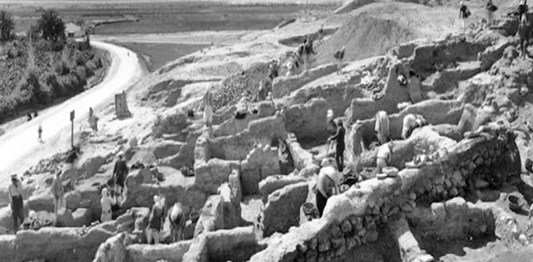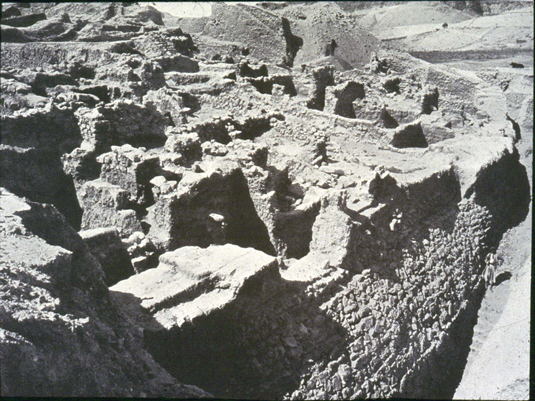HOME / Table of Contents = Civilizations - Cultures - Areas - Regions - Prehistory
Other Archaeological Sites / The Neolithic of the Levant (500 Page Book Online)
Ancient Jericho (Tell Sultan)
ProofRead and Updated March 21st 2020

Neolithic tower discovered and excavated by Kathleen Kenyon in Trench I ... The tower was built and destroyed
in Pre-Pottery Neolithic A which Kenyon dated to 8000-7000 BC (National Geographic)
Selected Excerpts on Jericho:
The Neolithic of the Levant (1978)
A.M.T. Moore (Oxford University)
(1) Neolithic 1: (Pages 87-99)
(2) Neolithic 2: (Pages 211-218)
(3) Neolithic 4: (Pages 451-453)
Pre-History and Archaeology Glossary

 Known today as Tell Sultan, Jericho lies in an oasis in the Jordan Valley north of the Dead Sea on a main east-west route. Its long stratigraphy documents almost continuous occupation from before 9000 BC to circa 1580 BC. At the base of the tell (mound) was a Natufian Culture deposit associated with a rectangular platform surrounded by stone walls; interpreted by the excavator Kathleen Kenyon as a shrine. The Natufian deposit was four metres thick in places but has provided little evidence of other structural remains or of subsistence economy. It was succeeded by Pre-Pottery Neolithic A (PPNA) levels with radiocarbon dates in the range 8350-7370 BC. At this stage the settlement covered a surprisingly large four hectares and was surrounded by a stone wall and a ditch reinforced by at least one massive stone tower. The houses of this period were round and built of mud-brick.
Known today as Tell Sultan, Jericho lies in an oasis in the Jordan Valley north of the Dead Sea on a main east-west route. Its long stratigraphy documents almost continuous occupation from before 9000 BC to circa 1580 BC. At the base of the tell (mound) was a Natufian Culture deposit associated with a rectangular platform surrounded by stone walls; interpreted by the excavator Kathleen Kenyon as a shrine. The Natufian deposit was four metres thick in places but has provided little evidence of other structural remains or of subsistence economy. It was succeeded by Pre-Pottery Neolithic A (PPNA) levels with radiocarbon dates in the range 8350-7370 BC. At this stage the settlement covered a surprisingly large four hectares and was surrounded by a stone wall and a ditch reinforced by at least one massive stone tower. The houses of this period were round and built of mud-brick.
The population was already growing emmer wheat -- barley -- pulses while the meat portion of the diet was supplied in the main by gazelle supplemented by wild cattle -- boar -- goat. It is possible that some of these animals were being herded although the evidence is exiguous (scanty or inadequate). In the succeeding Pre-Pottery Neolithic B (PPNB) levels (with radiocarbon dates 7220-5850 BC) rectangular houses with plastered floors and walls were built; an increased range of cultivated plants was exploited and it is possible that domesticated sheep were kept. Evidence of an ancestor cult is present in the form of skulls with facial features restored in plaster and in some cases eyes set with cowrie or other shells. A break in occupation followed the PPNB levels but there is evidence of some re-occupation in later Neolithic and Chalcolithic times. From the late 4th millennium BC there was a walled town on the site which was continuously occupied until circa 1580 BC when the settlement, with a sloping plastered ramp of Hyksos type, was destroyed by the Egyptians (AHSFC).

Ruins from the walls of Jericho. Garstang believed these
to be the walls destroyed by the Israelites under Joshua


Jericho Middle Bronze Age Rampart
The History of the Ancient Near East Electronic Compendium




